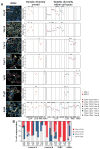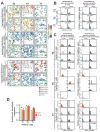Genetic and phenotypic diversity in breast tumor metastases
- PMID: 24448237
- PMCID: PMC3963810
- DOI: 10.1158/0008-5472.CAN-13-2357-T
Genetic and phenotypic diversity in breast tumor metastases
Abstract
Metastatic disease is the main cause of cancer-related mortality due to almost universal therapeutic resistance. Despite its high clinical relevance, our knowledge of how cancer cell populations change during metastatic progression is limited. Here, we investigated intratumor genetic and phenotypic heterogeneity during metastatic progression of breast cancer. We analyzed cellular genotypes and phenotypes at the single cell level by performing immunoFISH in intact tissue sections of distant metastatic tumors from rapid autopsy cases and from primary tumors and matched lymph node metastases collected before systemic therapy. We calculated the Shannon index of intratumor diversity in all cancer cells and within phenotypically distinct cell populations. We found that the extent of intratumor genetic diversity was similar regardless of the chromosomal region analyzed, implying that it may reflect an inherent property of the tumors. We observed that genetic diversity was highest in distant metastases and was generally concordant across lesions within the same patient, whereas treatment-naïve primary tumors and matched lymph node metastases were frequently genetically more divergent. In contrast, cellular phenotypes were more discordant between distant metastases than primary tumors and matched lymph node metastases. Diversity for 8q24 was consistently higher in HER2(+) tumors compared with other subtypes and in metastases of triple-negative tumors relative to primary sites. We conclude that our integrative method that couples ecologic models with experimental data in human tissue samples could be used for the improved prognostication of patients with cancer and for the design of more effective therapies for progressive disease.
©2014 AACR
Conflict of interest statement
Figures




Comment in
-
Tumour heterogeneity: the cancer kaleidoscope.Nat Rev Cancer. 2014 Mar;14(3):151-2. doi: 10.1038/nrc3683. Nat Rev Cancer. 2014. PMID: 24561429 No abstract available.
References
-
- Fearon ER, Vogelstein B. A genetic model for colorectal tumorigenesis. Cell. 1990;61:759–67. - PubMed
-
- Sanger N, Effenberger KE, Riethdorf S, Van Haasteren V, Gauwerky J, Wiegratz I, et al. Disseminated tumor cells in the bone marrow of patients with ductal carcinoma in situ. Int J Cancer. 2011;129:2522–6. - PubMed
-
- Klein CA. Parallel progression of primary tumours and metastases. Nat Rev Cancer. 2009;9:302–12. - PubMed
Publication types
MeSH terms
Grants and funding
LinkOut - more resources
Full Text Sources
Other Literature Sources
Medical
Research Materials
Miscellaneous

